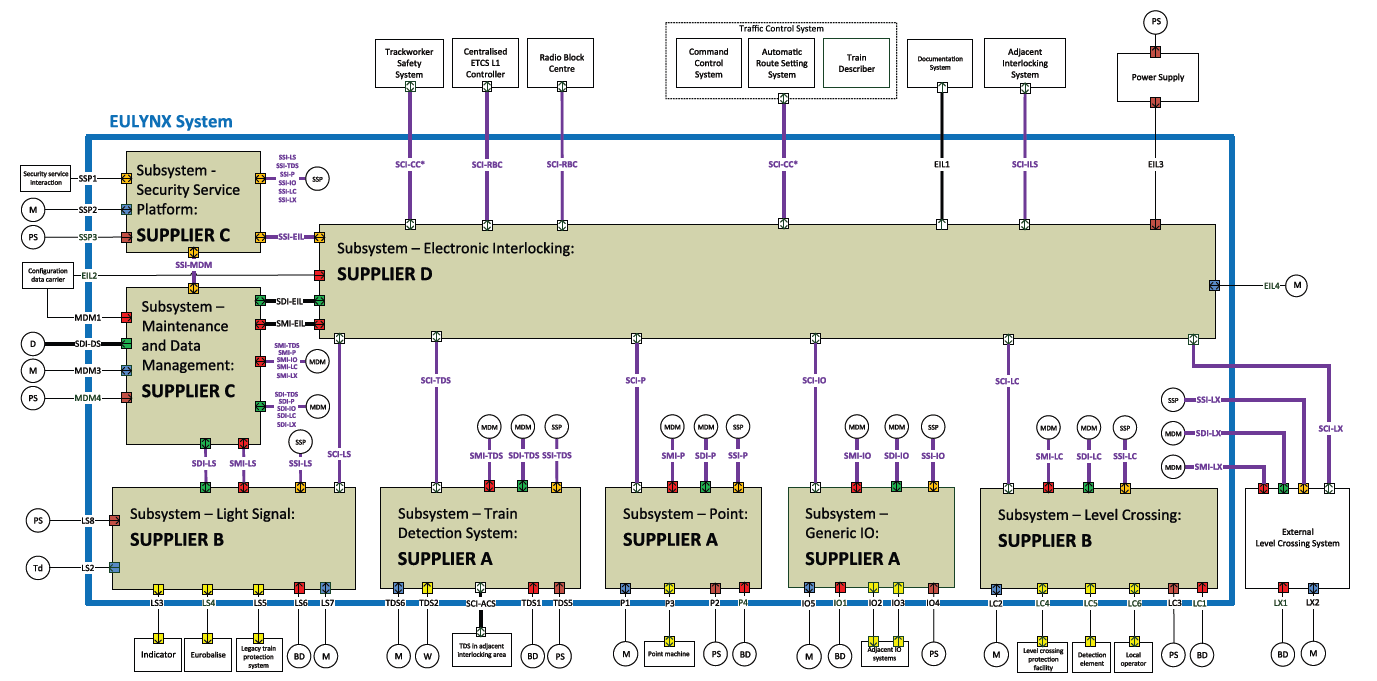Transformation of
Signalling Systems
with Wayside Object Controllers
Traditional centralised railway systems often encounter scalability challenges. These systems are typically designed in a fixed manner, which means that any efforts to upgrade or expand them are often very costly and complicated. However, wayside object controllers (WOCs) with EULYNX interface help to overcome such issues and thus offer an alternative solution. For instance, WOCs enable the creation of decentralised systems, which present the operator with a wide array of benefits, such as lower set-up and maintenance costs, greater flexibility, easier system upgrades and scalability, alongside many others.
In modern railway signaling architectures featuring WOCs, the interlocking can be situated in a central location or even in the cloud, while the control of various objects, such as track sections or points, remains at a local level.
This is because WOCs manage field elements and serve as a central link between them and the interlocking system. Furthermore, by managing and passing on essential data and commands from the interlocking system, WOCs are also able to provide status updates, as well as collect and transmit diagnostic data from the field elements.
For instance, in the example of a turnout, a WOC is responsible for the continuous monitoring and controlling of one or multiple associated point machines. It receives positioning instructions from the interlocking and activates the electrical supply to the motor. Additionally, the WOC is able to evaluate the position switch of the point machine.

Fig 1: Signalling architecture with standardised WOCs
Important Role of EULYNX in Wayside Object Controllers
To ensure optimal performance and integration within modern railway systems, WOCs must fulfill several important requirements. These include maintaining the highest safety and security standards, offering various connectivity options, and providing a high level of modularity. WOCs can meet these demands mainly thanks to standardised interfaces like EULYNX.
EULYNX is a standardised framework designed to enhance interoperability and integration within railway signalling and control systems. It provides a set of standardised interfaces and protocols that facilitate seamless communication and data exchange between components and systems. For instance, thanks to EULYNX, WOCs enable greater interoperability between components and reduce vendor lock-in, which in turn promotes product diversity and grants the operator more choice in procuring components according to specific project requirements, irrespective of the manufacturer.
Furthermore, using WOCs alongside standardised interfaces allows for the decoupling of life cycles of signalling components and field elements. In practice, this separation leads to significant cost savings for operators, as only the components that require replacement are addressed, avoiding major system overhauls. By using WOCs, railway systems are future-proofed, enabling operators to seamlessly and cost-effectively integrate and adopt new technologies into the existing infrastructure.
Effective use of WOCs with EULYNX in practice
To ensure optimal performance and integration within modern railway systems, WOCs must fulfill several important requirements. These include maintaining the highest safety and security standards, offering various connectivity options, and providing a high level of modularity. WOCs can meet these demands mainly thanks to standardised interfaces like EULYNX.
EULYNX is a standardised framework designed to enhance interoperability and integration within railway signalling and control systems. It provides a set of standardised interfaces and protocols that facilitate seamless communication and data exchange between components and systems. For instance, thanks to EULYNX, WOCs enable greater interoperability between components and reduce vendor lock-in, which in turn promotes product diversity and grants the operator more choice in procuring components according to specific project requirements, irrespective of the manufacturer.
Furthermore, using WOCs alongside standardised interfaces allows for the decoupling of life cycles of signalling components and field elements. In practice, this separation leads to significant cost savings for operators, as only the components that require replacement are addressed, avoiding major system overhauls. By using WOCs, railway systems are future-proofed, enabling operators to seamlessly and cost-effectively integrate and adopt new technologies into the existing infrastructure.

Fig 1: Signalling architecture with standardised WOCs
Throughout his tenure with the organisation, Mr. Pytlik has played a pivotal role in shaping and expanding the axle counting business in Poland, driving awareness and interest in the technology. From the outset of Frauscher's entry into this strategically important market, he has been instrumental in driving the growth and development of Frauscher Poland. Likewise, Mr. Pytlik has played a key role in the certification of many Frauscher solutions for the Polish market, including the AZF, Frauscher Axle Counting System ACS2000, Frauscher Advanced Counter FAdC® as well as the Wheel Sensors RSR180 and RSR123.
In his new role as the Managing Director, Mr. Pytlik aims to focus on key strategic initiatives to ensure the sustained, long-term success of Frauscher Poland. Among these is the continuation of close cooperation with system integrators to connect the FAdC® via serial protocols with various systems, including interlockings, level crossings and block line systems. Likewise, Mr. Pytlik wishes to build upon the already established successes of the organisation and further expand Frauscher Poland’s presence in the tram market as well as the Warsaw Metro. The introduction of cutting-edge innovations to the Polish railway market will also remain a priority and in this respect, Mr. Pytlik aims to spearhead the propagation of new diagnostic and maintenance technologies which use remote access to vital data, including the cloud-based diagnostic platform, Frauscher Insights.
Frauscher Poland, a subsidiary of Frauscher Sensor Technology, was established 25 years ago, marking a significant milestone in the company's history. From its inception, Frauscher Poland has played vital role in the company's global operations, serving as a key hub for business development, innovation, and customer engagement. Mr. Pytlik has a proven track record of leadership and accomplishment in the railway industry, and his appointment signals commitment of Frauscher Sensor Technology to excellence, innovation, and customer satisfaction.

Sarah Amerstorfer
Head of Global Marketing
T +43 7711 2920-0
F +43 7711 2920-7500
E marketing@frauscher.com
















